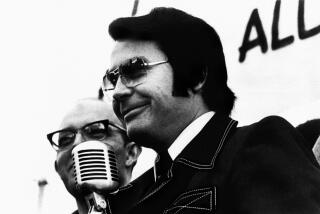‘Crypt’ Disinterred for HBO
- Share via
In one story, the principal character is an executioner who stays on the job even after the death penalty is banned, gleefully zapping acquitted murder suspects with his 2,000-volt portable death set.
Another story features a housewife who earnestly drives a poker into her husband’s skull on Christmas Eve--”Merry Christmas, darling!”--then faces an ax-wielding Santa who makes her wish there was still a good man around the house.
In Story 3, the hero is a Skid Row bum who is given nine lives through a surgical experiment and quickly blows one of them in a murder-suicide that takes out his doctor.
Eh-eh-eh-eh. They don’t write heroes like they did in the ghoul old days, eh, kiddies? Not since our moms and dads wrote to their congressmen and started all that fuss that forced E.C. Comics to drop Tales From the Crypt, Vault of Horror and Haunt of Fear back in the safety-first ‘50s.
Between 1950 and 1954, E.C. Comics published more than 500 devilish little tales, ironically twisted dark comedies illustrated by some of America’s top artists and read by some of its weirdest kids. Now, 35 years after the last bloody stroke was drawn, the vault to E.C.’s horrors has been reopened, and some of its juicier yarns are being adapted for HBO by such star directors as Robert Zemeckis, Walter Hill and Richard Donner.
Is cable a good deal, or what?
“These are terrific stories which have survived over several decades,” said HBO’s Chris Albrecht, the programming executive who green-lighted the first six episodes of producer Joel Silver’s “Tales From the Crypt” series. “Strong story material will always make for better films and these stories are very special.”
June is “Crypt” month at HBO. The pay service will air the first three episodes as a trilogy on Saturday at 9:30 p.m., then will follow each Wednesday through the month with episodes 4, 5 and 6. The trilogy, which is narrated from a dank dungeon by a decaying animatronic Crypt Keeper, features Hill’s “The Man Who Was Death,” about the overzealous executioner, Zemeckis’ “And All Through the House,” the tale of a Christmas Eve gone wrong, and Donner’s “Dig That Cat . . . He’s Real Gone,” about the bum with nine lives.
The other three episodes in the HBO can, made at an average of $850,000, were directed by Howard Deutsch, Mary Lambert and Tom Holland. Saturday’s trilogy has better known directors, but the last three episodes have better known actors--among them Lea Thompson, Amanda Plummer, Audra Lindley and M. Emmet Walsh.
If the ratings are good, HBO’s next step would be to OK another 19 shows, then 40 more. That would barely tap the supply; Silver has optioned all 530 stories published in E.C.’s three horror-suspense magazines.
“I was raised on D.C. comics myself--Batman, Superman, all those,” said Silver, the 36-year-old producer whose string of 1980s action hits include “48 HRS.,” “Die Hard,” “Predator” and “Lethal Weapon.” “I was aware of the E.C. comics, but it wasn’t until they were reissued in bound volumes that I thought about adapting them.”
Those volumes came out about the time Steven Spielberg announced plans to produce “Twilight Zone--The Movie.” Had that ill-fated project been a box-office success, suspense-horror trilogies would have been hot. So Silver met with E.C. publisher William Gaines, worked out some lingering contractual entanglements with the British producer who made two “Crypt” movies in the early ‘70s, and tied up the movie rights.
But after “Twilight Zone’s” poor box-office performance and the cool reception given to George Romero’s E.C. homage, “Creepshow,” getting financial backing for the “Crypt” proved more difficult than inscribing a tombstone with your fingernails.
“I had the greatest directors in town wanting to do them, but I couldn’t get anybody interested,” Silver said. “I took (the project) everywhere and no one would take me seriously.”
Creative Artists agent Lee Gabler finally convinced Silver that the right venue for “Crypt” was pay-cable, and HBO, which was winding down on its “Tales From the Dark Side” series, was looking for something in that genre.
“It was a very quick deal,” Silver said. “They had some restrictions--they wanted heavyweight directors, strong scripts and casts--but they were things we wanted, too, and they gave us a commitment to fund the show.”
HBO agreed to put up a $450,000 licensing fee for each of the first six episodes (the series will be repeated in July) and for the American video rights. Universal Pictures has bought the foreign rights and, according to Silver, plans to release the first three as a feature trilogy in foreign markets.
Albrecht said the “Crypt” series fits perfectly into HBO’s something-(that you won’t see on network TV)-for-everybody programming concept.
“We strive to bring the best TV that is not available on the commercial networks that is worth paying for,” Albrecht said. “You’d never see anything like this on a network.”
Not on your life. Hill’s opening episode alone would earn the trilogy a theatrical R rating. There is nudity, strong profanity and a couple of on-camera electrocutions that will send viewers to bed arguing over who’s going to turn out the lights. Zemeckis’ Christmas story opens with the unsuspecting husband getting the poker plunged into his head. And in Donner’s “Dig That Cat . . . ,” we watch the same guy buy the farm nine ways.
The style of the episodes are dramatically different, but in each case, the directors have attempted to preserve the black humor of the comics and remain faithful to the climactic ironies that made the magazines so memorable.
Hill, who is old enough to have been a first generation E.C. fan, said he has wanted to adapt the executioner episode for years, but never would have had the chance without the HBO series.
“This would never be a movie--the material is too thin--and it would never be on network TV because it’s too strong,” Hill said. “If it was ever going to be done, this is the only way.”
Zemeckis, who isn’t old enough to remember the original stories, said the attraction for him was making the sort of film he couldn’t do otherwise.
“To be perfectly frank, with my career at this point, I couldn’t do a feature horror or terror picture,” said Zemeckis, whose recent hits include “Back to the Future” and “Who Framed Roger Rabbit.” “For me, being able to make something that terrifies people and makes them smile at the same time is great fun.”
Zemeckis, Hill and Donner had complete creative control over their segments, from script approval to casting, and finished each episode in a tidy eight days. (As co-executive producers with Silver and David Giler, they will also see a little something extra in their pay envelopes.) Silver said the advantage of the series is that the short shooting schedule and the two-week editing period allows major directors to work a “Crypt” in around their other feature work and still work with a budget that assures first-rate production--top cinematographers and set designers, the composer of the director’s choice and special effects experts.
“It’s fun not having to be concerned with the fate of an entire studio resting on what you’re doing,” Zemeckis said. “You can try some things, be a little looser; it’s like comedians going to the Improv to test material is the way I look at it.”
E.C. Comics founder Bill Gaines has seen only Zemeckis’ episode, which is based on a story he co-wrote.
“I thought it was well done,” Gaines said. “It doesn’t follow the (story) exactly, but Hollywood never does.”
Gaines said his deal with Silver gives him “the right to make suggestions,” and it is apparently working out better than the “script approval” he had for the film versions made nearly two decades ago.
“I didn’t like the films; they did stupid things that I was dead against and they just ran roughshod over me,” he said. “They were going to put a different ending on the Christmas story (for the HBO series). I asked them not to and they didn’t, which made me very happy.”
Gaines inherited a publishing business from a father who started America’s first regular comic strip, Famous Funnies, and said he published Tales From the Crypt, Vault of Horror and Haunt of Fear mostly for his own amusement. He said the circulation of E.C. Comics (the initials originally stood for Educational Comics but the name was changed to Entertaining Comics) never exceeded 300,000 per issue, and the profits were less than $40,000 a year.
When the E.C. Comics became the subject of a Senate subcommittee hearing on juvenile delinquency, Gaines’ wholesalers balked at handling the magazines, and Gaines--then busy with his new creation, Mad Magazine--decided they weren’t worth the aggravation.
Both the E.C. Comics and Mad have been imitated dozens of times, but Gaines said those events have never bothered him.
“Listen, I got my inspiration from the radio programs I grew up with and the pulp novels I read as a kid,” he said. “Every group borrows from what came before. I figure I got it coming.”
More to Read
The complete guide to home viewing
Get Screen Gab for everything about the TV shows and streaming movies everyone’s talking about.
You may occasionally receive promotional content from the Los Angeles Times.






